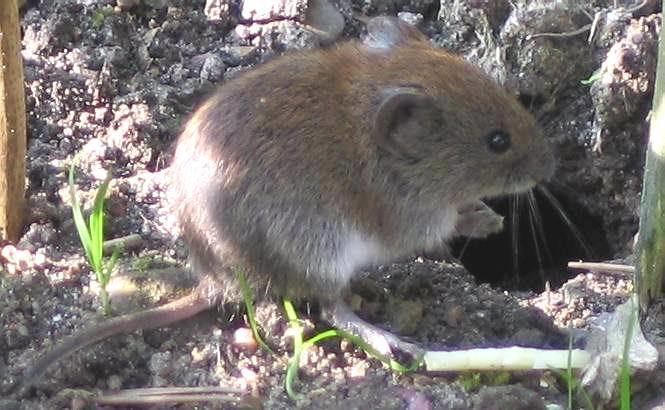This is a list of the mammal species recorded in Denmark. There are 57 mammal species in Denmark, of which 0 are critically endangered, 0 are endangered, 4 are vulnerable, and 2 are near-threatened.
The following tags are used to highlight each species' conservation status as assessed by the IUCN:
Some species were assessed using an earlier set of criteria. Species assessed using this system have the following instead of near threatened and least concern categories:
Rodents make up the largest order of mammals, with over 40 percent of mammalian species. They have two incisors in the upper and lower jaw which grow continually and must be keep short by gnawing. Most rodents are small though the capybara can weigh up to 45 kg (100 lb).
Suborder: Sciurognathi
Family: Sciuridae (squirrels)
Subfamily: Sciurinae
Tribe: Sciurini
Genus: Sciurus
Red squirrel Sciurus vulgaris NT
Family: Castoridae
Genus: Castor
Eurasian beaver Castor fiber LR/lc (reintroduced)
Family: Gliridae (dormice)
Subfamily: Leithiinae
Genus: Muscardinus
Hazel dormouse Muscardinus avellanarius LR/nt
Family: Dipodidae (jerboas)
Subfamily: Sicistinae
Genus: Sicista
Northern birch mouse Sicista betulina LR/nt
Family: Cricetidae
Subfamily: Arvicolinae
Genus: Arvicola
Water vole Arvicola terrestris LR/lc
Genus: Clethrionomys
Bank vole Clethrionomys glareolus LR/lc
Genus: Microtus
Field vole Microtus agrestis LR/lc
Common vole Microtus arvalis LR/lc
Family: Muridae (mice, rats, voles, gerbils, hamsters, etc.)
Subfamily: Murinae
Genus: Apodemus
Striped field mouse Apodemus agrarius LR/lc
Wood mouse Apodemus sylvaticus LC
Genus: Micromys
Harvest mouse Micromys minutus LR/nt
The lagomorphs comprise two families, Leporidae (hares and rabbits), and Ochotonidae (pikas). Though they can resemble rodents, and were classified as a superfamily in that order until the early 20th century, they have since been considered a separate order. They differ from rodents in a number of physical characteristics, such as having four incisors in the upper jaw rather than two.
Family: Leporidae (rabbits, hares)
Genus: Oryctolagus
European rabbit Oryctolagus cuniculus LR/lc
Genus: Lepus
European hare Lepus europaeus LR/lc
The order Erinaceomorpha contains a single family, Erinaceidae, which comprise the hedgehogs and gymnures. The hedgehogs are easily recognised by their spines while gymnures look more like large rats.
Family: Erinaceidae (hedgehogs)
Subfamily: Erinaceinae
Genus: Erinaceus
West European hedgehog Erinaceus europaeus LR/lc
The "shrew-forms" are insectivorous mammals. The shrews and solenodons closely resemble mice while the moles are stou- bodied burrowers.
Family: Soricidae (shrews)
Subfamily: Soricinae
Tribe: Nectogalini
Genus: Neomys
Eurasian water shrew Neomys fodiens LR/lc
Tribe: Soricini
Genus: Sorex
Common shrew Sorex araneus LR/lc
Eurasian pygmy shrew Sorex minutus LR/lc
Family: Talpidae (moles)
Subfamily: Talpinae
Tribe: Talpini
Genus: Talpa
European mole Talpa europaea LR/lc
The bats' most distinguishing feature is that their forelimbs are developed as wings, making them the only mammals in the world naturally capable of flight. Bat species account for about 20% of all mammals.
Family: Vespertilionidae
Subfamily: Myotinae
Genus: Myotis
Brandt's bat Myotis brandti LR/lc
Pond bat Myotis dasycneme VU
Daubenton's bat Myotis daubentonii LR/lc
Whiskered bat Myotis mystacinus LR/lc
Natterer's bat Myotis nattereri LR/lc
Subfamily: Vespertilioninae
Genus: Barbastella
Barbastelle Barbastella barbastellus VU
Genus: Eptesicus
Serotine bat Eptesicus serotinus LR/lc
Genus: Nyctalus
Common noctule Nyctalus noctula LR/lc
Genus: Pipistrellus
Common pipistrelle Pipistrellus pipistrellus LC
Genus: Plecotus
Brown long-eared bat Plecotus auritus LR/lc
Genus: Vespertilio
Parti-coloured bat Vespertilio murinus LR/lc
Family: Molossidae
Genus: Tadarida
European free-tailed bat Tadarida teniotis LR/lc
The order Cetacea includes whales, dolphins and porpoises. They are the mammals most fully adapted to aquatic life with a spindle-shaped nearly hairless body, protected by a thick layer of blubber, and forelimbs and tail modified to provide propulsion underwater.
Suborder: Mysticeti
Family: Balaenidae (right whales)
Genus: Balaena
North Atlantic right whale Eubalaena glacialis♠ CR or Functionally Extinct in Eastern Atlantic
Family: Eschrichtiidae (gray whales)
Genus: Eschrichtius
North Atlantic gray whale Eschrichtius robustus♠ EX
Family: Balaenopteridae
Subfamily: Balaenopterinae
Genus: Balaenoptera
Fin whale Balaenoptera physalus♠ EN
Common minke whale Balaenoptera acutorostrata♠ LC
Subfamily: Megapterinae
Genus: Megaptera
Humpback whale Megaptera novaeangliae♠ LC
Suborder: Odontoceti
Family: Phocoenidae
Genus: Phocoena
Harbour porpoise Phocoena phocoena♠ VU
Family: Monodontidae
Genus: Delphinapterus
Beluga Delphinapterus leucas♠ VU
Family: Ziphidae
Genus: Mesoplodon
Sowerby's beaked whale Mesoplodon bidens♠ DD
Family: Delphinidae (marine dolphins)
Genus: Delphinus
Common dolphin Delphinus delphis LR/lc♠
Genus: Lagenorhynchus
White-beaked dolphin Lagenorhynchus albirostris♠ LR/lc
Atlantic white-sided dolphin Lagenorhynchus acutus♠ LR/lc
Genus: Tursiops
Bottlenose dolphin Tursiops truncatus♠ DD
Genus: Grampus
Risso's dolphin Grampus griseus♠ DD
Genus: Pseudorca
False killer whale Pseudorca crassidens♠ LR/lc
Genus: Globicephala
Long-finned pilot whale Globicephala melas♠ LR/lc
Genus: Orcinus
Orca Orcinus orca♠ DD
There are over 260 species of carnivorans, the majority of which eat meat as their primary dietary item. They have a characteristic skull shape and dentition.
Suborder: Caniformia
Family: Canidae (dogs, foxes)
Genus: Vulpes
Red fox Vulpes vulpes LC
Genus: Canis
Gray wolf Canis lupus EX
Family: Ursidae (bears)
Genus: Ursus
Brown bear Ursus arctos EX
Family: Mustelidae (mustelids)
Genus: Mustela
Stoat Mustela erminea LR/lc
Least weasel Mustela nivalis LR/lc
European polecat Mustela putorius LR/lc
Genus: Martes
Beech marten Martes foina LR/lc
Pine marten Martes martes LR/lc
Genus: Meles
Eurasian badger Meles meles LR/lc
Genus: Lutra
European otter Lutra lutra NT
Family: Odobenidae
Genus: Odobenus
Walrus Odobenus rosmarus LR/lc
Family: Phocidae (earless seals)
Genus: Cystophora
Hooded seal Cystophora cristata LR/lc
Genus: Phoca
Common seal Phoca vitulina LR/lc
The even-toed ungulates are ungulates whose weight is borne about equally by the third and fourth toes, rather than mostly or entirely by the third as in perissodactyls. There are about 220 artiodactyl species, including many that are of great economic importance to humans.
Family: Cervidae (deer)
Subfamily: Cervinae
Genus: Cervus
Red deer Cervus elaphus LR/lc
Subfamily: Capreolinae
Genus: Capreolus
Roe deer Capreolus capreolus LR/lc

